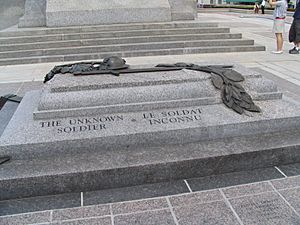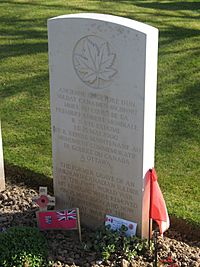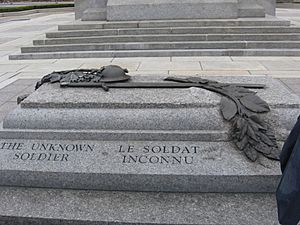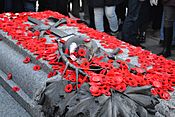Canadian Tomb of the Unknown Soldier facts for kids

Canadian Tomb of the Unknown Soldier at Confederation Square
|
|
| Coordinates | 45°25′26.53″N 75°41′43.79″W / 45.4240361°N 75.6954972°W |
|---|---|
| Location | Ottawa, Ontario, Canada |
| Designer | Public Works and Government Services Canada, Mary-Ann Liu |
| Type | War memorial |
| Material | Granite and bronze |
| Length | 3.5 metres (12 ft) |
| Width | 2.5 metres (8 ft) |
| Height | 1 metre (3 ft) |
| Opening date | May 28, 2000 |
| Dedicated to | All persons who served and did not return home |
The Canadian Tomb of the Unknown Soldier (French: Tombe du Soldat Inconnu) is a special tomb in Ottawa, Ontario. It is located in front of the National War Memorial in Confederation Square. This tomb honors all Canadian service members. It holds the remains of a soldier who died in France during World War I. This soldier was chosen from a war grave near Vimy, where the famous Battle of Vimy Ridge took place.
The tomb was added to the National War Memorial in the year 2000. This project was started by the Royal Canadian Legion. Since 2007, members of the Canadian Armed Forces stand guard at the tomb. They do this from April to November each year.
Contents
The Unknown Soldier's Story
Choosing the Soldier
The Royal Canadian Legion asked the Canadian government to create a tomb for an unknown soldier. This was part of a special program called the Canada Millennium Partnership Program. The government asked the Commonwealth War Graves Commission to help. They needed to choose one of 1,603 graves of unknown Canadians. These graves were all near Vimy Ridge in France.
Grave 7 was chosen. It was in the Cabaret-Rouge British Cemetery in Souchez, France. This area is close to the Vimy Ridge memorial. The Battle of Vimy Ridge was the first big battle where all four Canadian divisions fought together.
Journey to Canada
The soldier's remains were carefully removed from the grave on May 16, 2000. The coffin was then flown to Ottawa on May 25. A group of 45 people, including a chaplain, veterans, and young Canadians, came with the soldier.
In Ottawa, the unknown soldier lay in state for three days. This means the coffin was placed in the Hall of Honour on Parliament Hill for people to pay their respects.
A Special Burial
On May 28, the soldier's body was taken to the National War Memorial. It was carried on a horse-drawn carriage. Many important people were there, including Governor General Adrienne Clarkson and Prime Minister Jean Chrétien. Veterans and military members also joined the procession.
With full military honors, the soldier was re-buried in a special stone coffin. About 20,000 people watched. Before the tomb was sealed, members of the Legion placed soil on the casket. This soil came from every Canadian province and territory. It also included soil from the soldier's original grave site in France.
Remembering the Soldier
The original headstone from the unknown soldier's grave is now in the Canadian War Museum. It is the main item in the Memorial Hall exhibit. The hall is designed so that sunlight shines on the headstone only once a year. This happens on Remembrance Day, November 11, at 11:00 am.
At the soldier's former burial site in France, a new grave marker was placed. It looks like the other headstones in the cemetery. It has these words written on it:
ANCIENNE SÉPULTURE D'UN
SOLDAT CANADIEN INCONNU
MORT AU COURS DE LA
PREMIÈRE GUERRE MONDIALE.
IL A ÉTÉ EXHUMÉ
LE 25 MAI 2000
ET IL REPOSE MAINTENANT AU
MONUMENT COMMÉMORATIF
DE GUERRE DU CANADA
À OTTAWA
THE FORMER GRAVE OF AN
UNKNOWN CANADIAN SOLDIER
OF THE FIRST WORLD WAR.
HIS REMAINS WERE REMOVED
ON 25 MAY 2000 AND NOW
LIE INTERRED AT THE
NATIONAL WAR MEMORIAL
IN OTTAWA CANADA.
About the Tomb Itself
The tomb honors all Canadians who have died in combat. This includes about 116,000 Canadians. It also honors all members of the Canadian Armed Forces who have died or may die in any conflict.
The tomb is 3.5 meters (12 feet) long, 2.5 meters (8 feet) wide, and 1 meter (3 feet) high. It is made of Caledonia granite, a type of stone from Quebec. It also has a bronze sculpture and four bronze pieces at its corners. The granite was chosen because its color matches the war memorial.
Design and Symbols
The bronze parts were designed by Canadian artist Mary-Ann Liu. They show a medieval sword, a World War I helmet, and branches of maple and laurel leaves. Maple leaves are a symbol of Canada. Laurel leaves represent victory and death.
Three of the corner pieces show different versions of the Memorial Cross. This cross is given to families of soldiers who die in service. The fourth corner piece is a poppy, a symbol of remembrance.
The design of the tomb was chosen from six ideas by Canadian artists. It looks similar to the Vimy Memorial in France. The tomb area is cared for by Public Works and Government Services Canada.
Traditions at the Tomb
The tomb is a very important place for all remembrance events. On the first Remembrance Day after the tomb was built, a new tradition began. People spontaneously started placing their poppies on the tomb.
Now, people also leave cut flowers, photos, or letters for those who died. This show of respect also happens on Canada Day. On that day, people leave small paper Canadian flags on the tomb.
In 2001, the Royal Canadian Legion asked artist André Gauthier to create a small artwork about the Tomb of the Unknown Soldier.
The Sentries
Who Are They?
Since 2007, two sentries from the Ceremonial Guard stand watch at the tomb. They wear their full dress uniforms and carry unloaded weapons. They are on duty from 9 am to 5 pm.
At first, this program only ran in July and August. In 2014, it was made longer. Now, sentries are there from April 9 (the start date of the Battle of Vimy Ridge) to November 10. They also stand guard during other important military anniversaries.
Their Duties
Each morning, the first sentries march out with a piper. When they take their posts, a non-commissioned member reads them their orders. They stand at ease, holding their weapon with their right arm fully extended. Their head is up, and their feet are 30 inches apart.
Sentries stand at their post for one hour before being replaced. Sometimes, a sentry might do two shifts in one day. Sentries on duty can march their "beat." The senior sentry taps the ground with their rifle. The other sentry taps their rifle to acknowledge. After a short pause, both sentries come to attention. They take a step forward, put their rifles on their shoulders, turn outwards, and start marching. They march nine paces, then turn around and return to their starting spot. They can continue marching their beat for the whole hour if they wish. Sentries are not allowed to talk to the public.

Where Sentries Come From
The Ceremonial Guard includes members from all parts of the Canadian Forces. This means the sentries can be from the Canadian Army, the Royal Canadian Navy, or the Royal Canadian Air Force. They can also be from the Special Operations Command. The commanding officer of each unit decides who will be sent to Ottawa.
Sometimes, police officers act as sentries. For example, officers from the Royal Canadian Mounted Police stood guard on July 5, 2013. They did this to honor Sergeant Arthur Herbert Lindsay Richardson, a police member who earned a special medal called the Victoria Cross during the Second Boer War.
Images for kids







